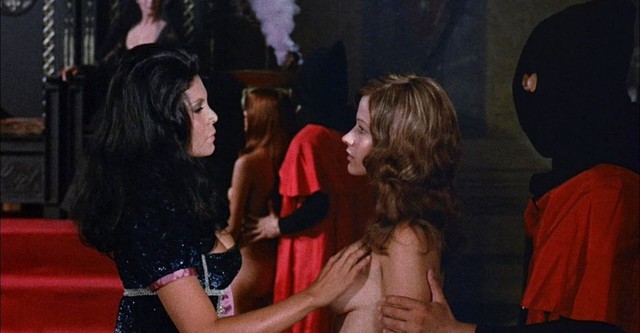
The Devil’s Wedding Night (1973) reimagines the legend of Erzsébet Báthory as a vehicle for Mark Damon. In The Devil’s Wedding Night Damon plays twin brothers, Karl and Franz, who travel to Castle Dracula in Transylvania to find the fabled ring of the Nibelungen. But the Countess Dracula (Rosalba Neri) already possesses the ring and has been using its legendary powers to strengthen her vampiric abilities.
The screenplay for The Devil’s Wedding Night, by Luigi Batzella and Walter Brandi, draws heavily from the Hammer production Twins Of Evil (1971). But instead of twin sisters caught in the spell of Satan and an aristocratic vampire they’ve opted for twin brothers. So more than anything The Devil’s Wedding Night is a showcase for Mark Damon who, allegedly, fought for a couple of years to get this film made.
Unfortunately Mark Damon isn’t the kind of actor who can carry a film. Rosalba Neri, with her iconic beauty and expressive eyes, steals every scene she appears in even though she has only one-quarter of the lines that Damon has. Damon’s campy choices aren’t themselves out of place in The Devil’s Wedding Night, it’s just that they are delivered too broadly. The unfocused nature of his intent in either role conveys a sort of schizophrenic mania that hampers the affectiveness of his on screen heroics.
Though a lot is imported from Twins Of Evil to The Devil’s Wedding Night, the most important aspect to the dramatic success of Twins Of Evil is ignored; that component being the character of Gustav Weil (Peter Cushing). The Devil’s Wedding Night simply ignores the villagers within the complex of its narrative. There’s a slight nod at the beginning of the film to the disquiet in the village but no sense of the real effect that Countess Dracula, with all of her virgin sacrifices, has had. So rather than trapping Karl and Franz in the middle of a conflict between the wealthy and the poor, the virtuous and the satanic, The Devil’s Wedding Night allows them to exist as fundamentally good.
On a visual level directors Luigi Batzella and Joe D’Amato recreate, albeit with far more limited resources, the look of Hammer Horror pictures of the time. For the most part the low budget evocations of the Gothic work rather well and successfully convey a sense of atmosphere. It’s when the filmmakers channel the psychedelic strategies of the sixties avant-garde that, on a visual level, The Devil’s Wedding Night really gets interesting.
This is particularly true during the Black Mass wedding ceremony during the climax of the film. Rosalba Neri appears backlit then there’s a cut to lightning, a cut to the virgins making their way to the castle in answer to the Countess’ magical call, then back to Neri, then a shot of the ring, etc, etc. These rapid little montages and the use of negative exposure and expressionistic lighting imbue the film with an energy and ingenuity that is otherwise absent. It also suggests that Batzella and D’Amato were looking for influences outside of the Hammer canon.
As far as films about the infamous Erzsébet Báthory go I much preferred the Spanish film Blood Ceremony (1973) to The Devil’s Wedding Night. It’s no coincidence that both films come from a time when censorship was in decline. The legend of Erzsébet Báthory, with all of its sex and violence, was exactly what producers wanted to draw audiences. The gratuitous nudity and silly lesbian sex scenes that populate both films are a testament to the this fact. The narrative complexity and character sophistication of Blood Ceremony is simply more engaging even though superficially The Devil’s Wedding Night might be more fun.
